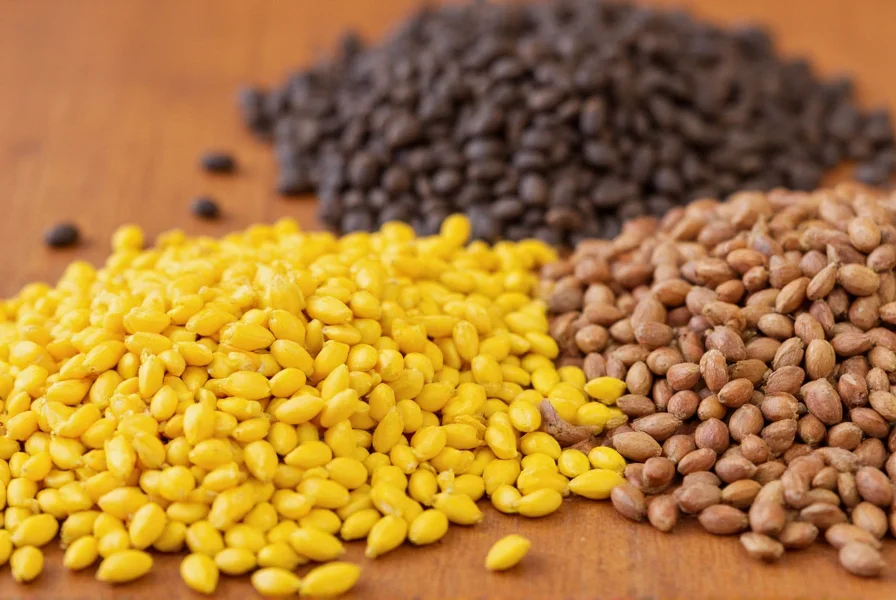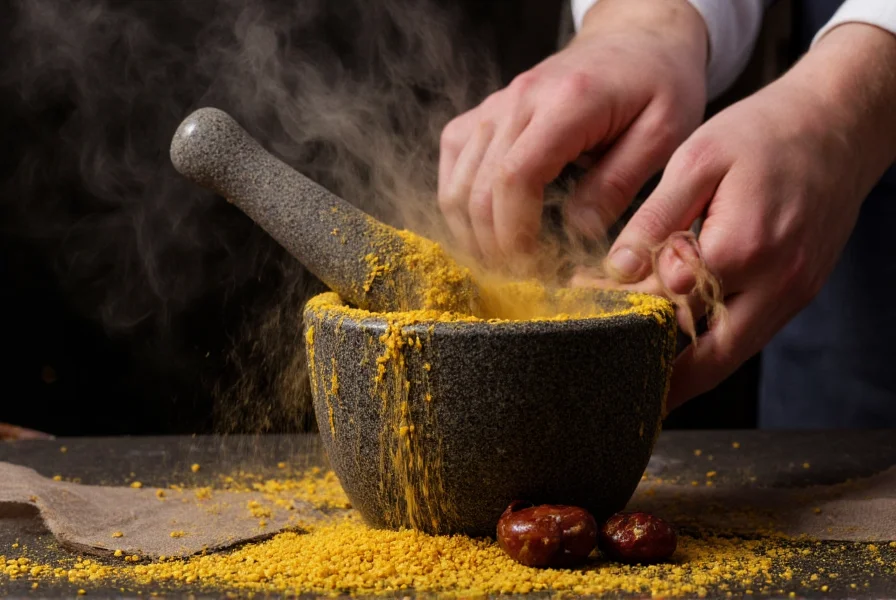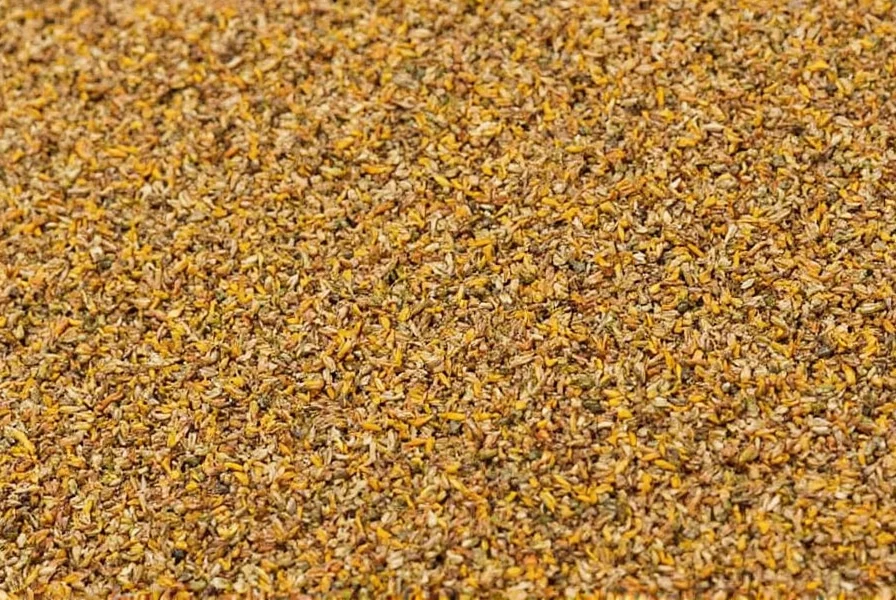Understanding what are mustard seeds involves exploring their botanical origins, culinary applications, and nutritional properties. These tiny powerhouses pack remarkable flavor and health benefits despite their minuscule size. Let's examine the different varieties, their unique characteristics, and how they transform cooking across global cuisines.
Three Main Types of Mustard Seeds
Mustard seeds come in three primary varieties, each with distinct flavor profiles and culinary applications:
| Type | Color | Flavor Intensity | Common Uses |
|---|---|---|---|
| Yellow/White | Pale yellow | Mild | American yellow mustard, pickling, salad dressings |
| Brown | Brown to reddish-brown | Moderate to hot | Dijon mustard, Indian curries, Chinese hot mustard |
| Black | Dark brown to black | Most pungent | South Indian cooking, Ethiopian spice blends, traditional Chinese medicine |
Physical Characteristics and Flavor Development
Measuring just 1-2 millimeters in diameter, mustard seeds appear unassuming but contain remarkable chemical complexity. The seeds themselves have minimal flavor until activated through specific processes. When dry, they offer little more than a nutty aroma. However, when crushed and combined with liquid—particularly acidic liquids like vinegar—the enzyme myrosinase interacts with glucosinolates to produce allyl isothiocyanate, the compound responsible for mustard's signature heat.
Understanding what are mustard seeds used for requires recognizing how preparation methods affect their flavor profile:
- Dry grinding creates a more intense, immediate heat
- Soaking in cold liquid produces milder flavor
- Adding hot liquid deactivates enzymes, resulting in less pungency
- Fermentation (as in traditional mustard making) develops complex flavors over time
Historical Significance and Global Distribution
Archaeological evidence shows mustard seeds were used as early as 3000 BCE in the Indus Valley civilization. Ancient Greeks and Romans ground mustard seeds to create early versions of prepared mustard, with the Romans particularly fond of mixing them with grape juice (mustum ardens, meaning "burning must"). The term "mustard" itself derives from the Latin "mustum" (young wine) and "ardeo" (to burn).
Where do mustard seeds come from today? Major producers include:
- Canada (largest global producer of yellow mustard seeds)
- Nepal and India (primary sources for brown and black varieties)
- United Kingdom (traditional mustard seed cultivation)
- United States (particularly in the Dakotas and Montana)
Nutritional Profile and Health Benefits
Mustard seeds nutritional value makes them more than just a flavoring agent. These tiny seeds pack impressive nutritional density:
- Rich in selenium and magnesium—essential minerals for metabolic function
- Contain omega-3 and omega-6 fatty acids
- Good source of dietary fiber and protein
- Contain antioxidants like carotenes and flavonoids
Research suggests potential health benefits of mustard seeds include anti-inflammatory properties, improved digestion, and possible cardiovascular benefits. However, these effects typically require consumption as part of a balanced diet rather than as a standalone remedy.
Culinary Applications Across Global Cuisines
How to use mustard seeds in cooking varies dramatically across culinary traditions. In Indian cuisine, mustard seeds are often tempered in hot oil at the beginning of cooking (known as "tadka"), releasing their nutty aroma and providing flavor foundation for curries and dals. French cuisine transforms them into smooth Dijon mustard through grinding with verjuice or wine. Southern American cooking features them prominently in classic yellow mustard and barbecue sauces.
Chefs seeking to maximize flavor should understand that different mustard seed varieties serve specific purposes. Yellow mustard seeds provide the familiar mild tang of ballpark mustard, while brown seeds create the sharper heat of Dijon. Black mustard seeds, the most pungent variety, feature prominently in Bengali and Ethiopian cooking where their intense flavor complements complex spice blends.
Storage and Preservation Techniques
Proper storage maintains the quality of mustard seeds. Keep whole seeds in airtight containers away from light and heat. Stored correctly, they remain viable for 3-4 years. Ground mustard loses potency more quickly—typically within 6-12 months. For extended freshness, refrigeration or freezing can preserve both whole and ground seeds.
When making prepared mustard at home, the curing process significantly affects flavor development. Allowing the mixture to rest for 1-2 weeks before use creates more complex flavors as the enzymatic reactions continue. The type of liquid used (vinegar, wine, beer, or water) also dramatically influences the final product's character.
Common Questions About Mustard Seeds
What are the differences between yellow and brown mustard seeds?
Yellow mustard seeds (Sinapis alba) have a mild, slightly tangy flavor and pale yellow color. They're commonly used in American-style yellow mustard and pickling. Brown mustard seeds (Brassica juncea) are more pungent with a hotter, more complex flavor profile and reddish-brown color. Brown seeds contain more erucic acid, creating a sharper heat, and are preferred for Dijon mustard and many Asian cuisines.
Can you eat mustard seeds raw?
Yes, you can eat mustard seeds raw, but they have minimal flavor in their dry state. Raw mustard seeds provide a mild nutty taste with little heat. The characteristic pungency develops only when the seeds are crushed and combined with liquid, which activates the enzyme myrosinase. Consuming raw mustard seeds in moderation is safe, but eating large quantities may cause digestive discomfort due to their high fiber content.
What are mustard seeds used for besides making mustard?
Beyond prepared mustard, mustard seeds serve multiple culinary purposes. In Indian cooking, they're tempered in hot oil to flavor curries and dals. They feature in pickling recipes worldwide, adding both flavor and preservative qualities. Chefs use them in spice rubs for meats, in salad dressings, and as a crunchy topping for breads and vegetables. Traditional medicine systems have also used mustard seeds for their warming properties in poultices and topical applications.
Are mustard seeds good for you?
Mustard seeds offer several nutritional benefits. They contain selenium, magnesium, omega-3 fatty acids, and dietary fiber. These nutrients support metabolic function, cardiovascular health, and digestion. The compounds that create mustard's heat (isothiocyanates) show antioxidant and anti-inflammatory properties in research studies. However, mustard seeds are typically consumed in small quantities, so their health impact comes from regular inclusion in a balanced diet rather than as a standalone remedy.
How do you activate the flavor in mustard seeds?
To activate mustard seed flavor, you need to break the seed coat and introduce moisture. Crushing or grinding the seeds exposes the enzyme myrosinase to the compound sinigrin. When combined with liquid (especially acidic liquids like vinegar or wine), a chemical reaction produces the pungent allyl isothiocyanate. For maximum heat, use cold liquid; hot liquid deactivates the enzyme, creating milder flavor. The mixture continues developing flavor over 1-2 weeks as it cures.


Understanding what are mustard seeds involves appreciating their remarkable transformation from inert seeds to pungent flavor powerhouses. These tiny botanical wonders have shaped culinary traditions across continents and millennia, proving that sometimes the smallest ingredients make the biggest impact. Whether you're exploring different types of mustard seeds for a new recipe or simply curious about this ancient spice, their versatility and complexity continue to inspire cooks and food scientists alike.











 浙公网安备
33010002000092号
浙公网安备
33010002000092号 浙B2-20120091-4
浙B2-20120091-4